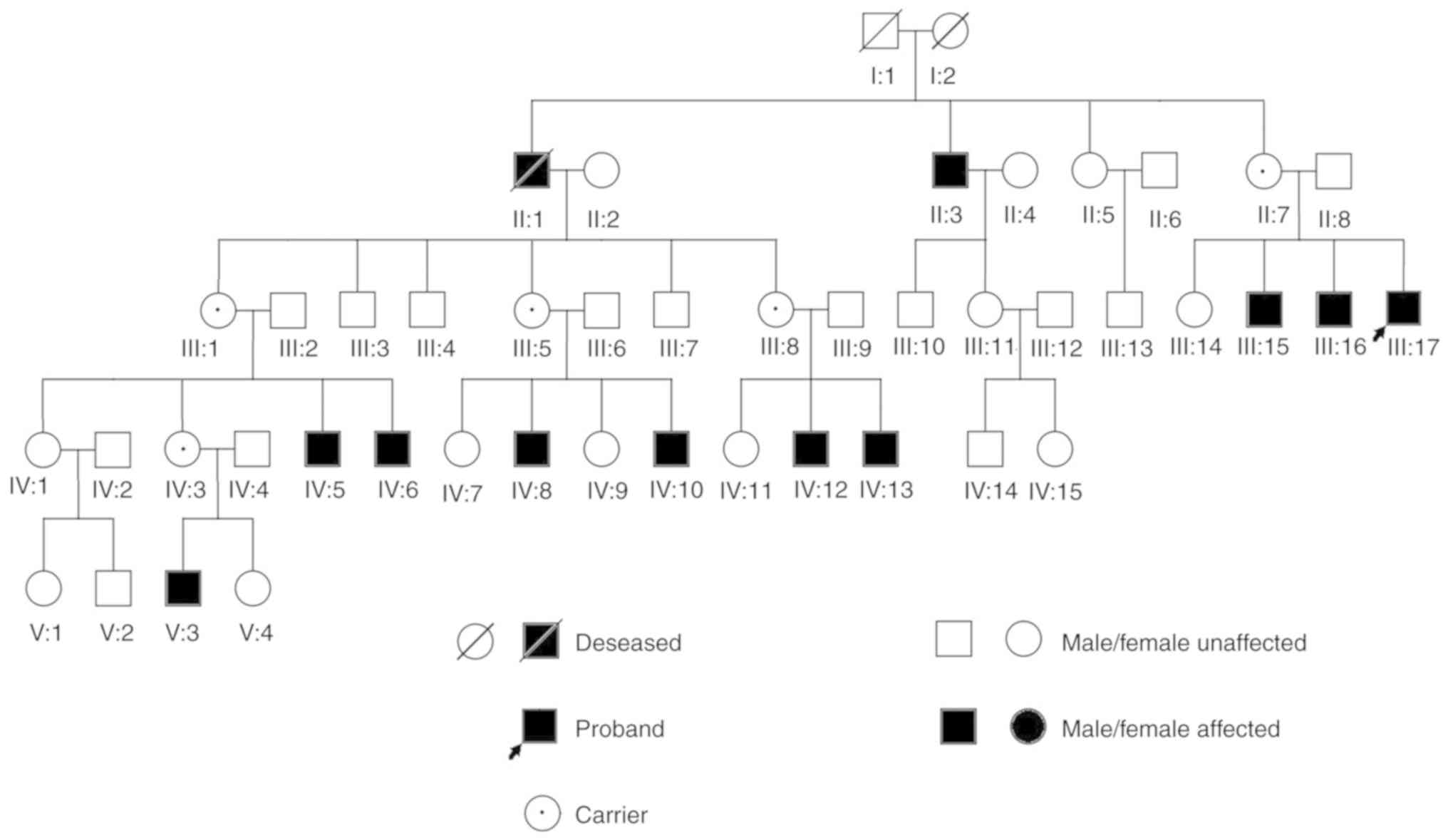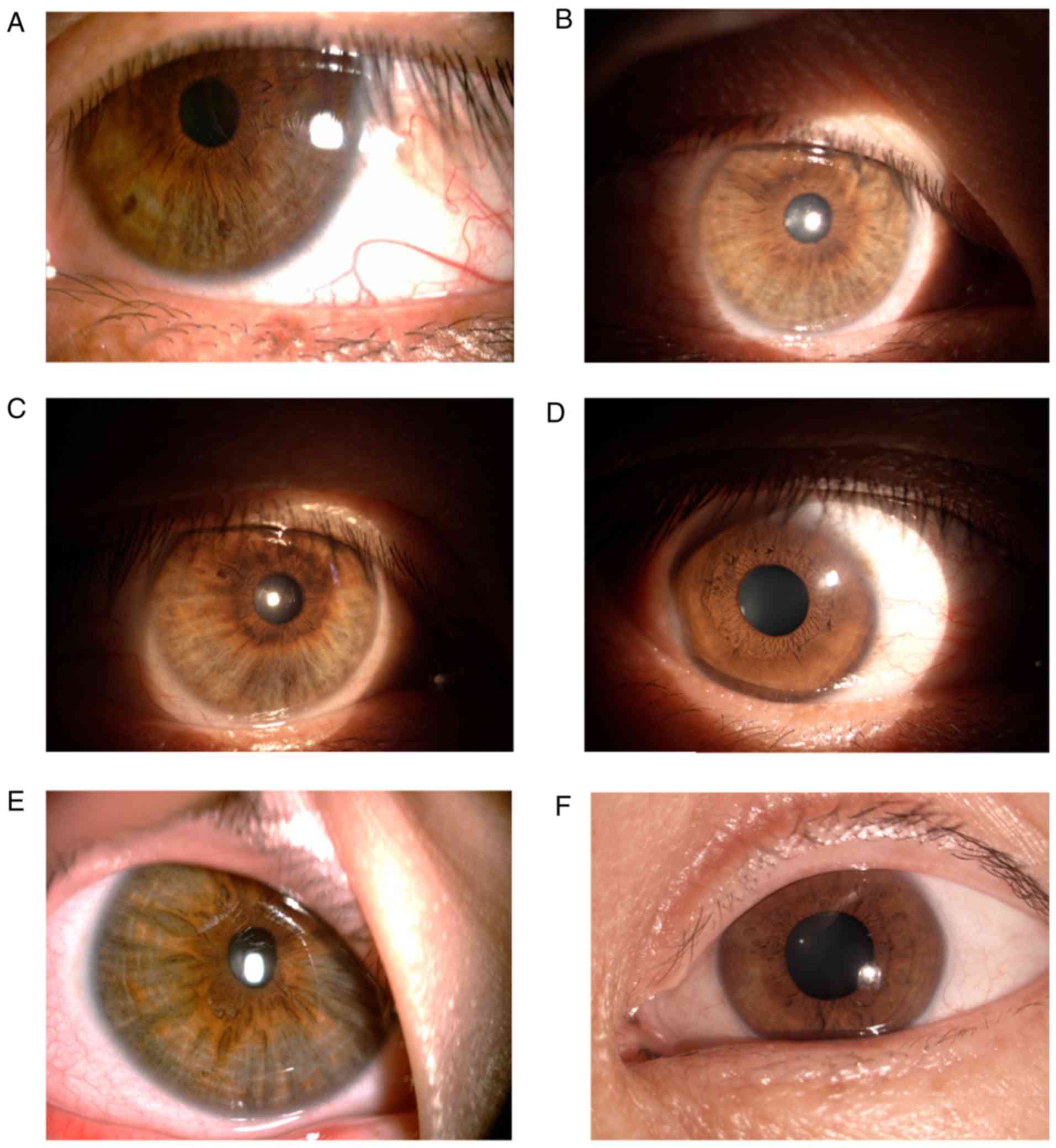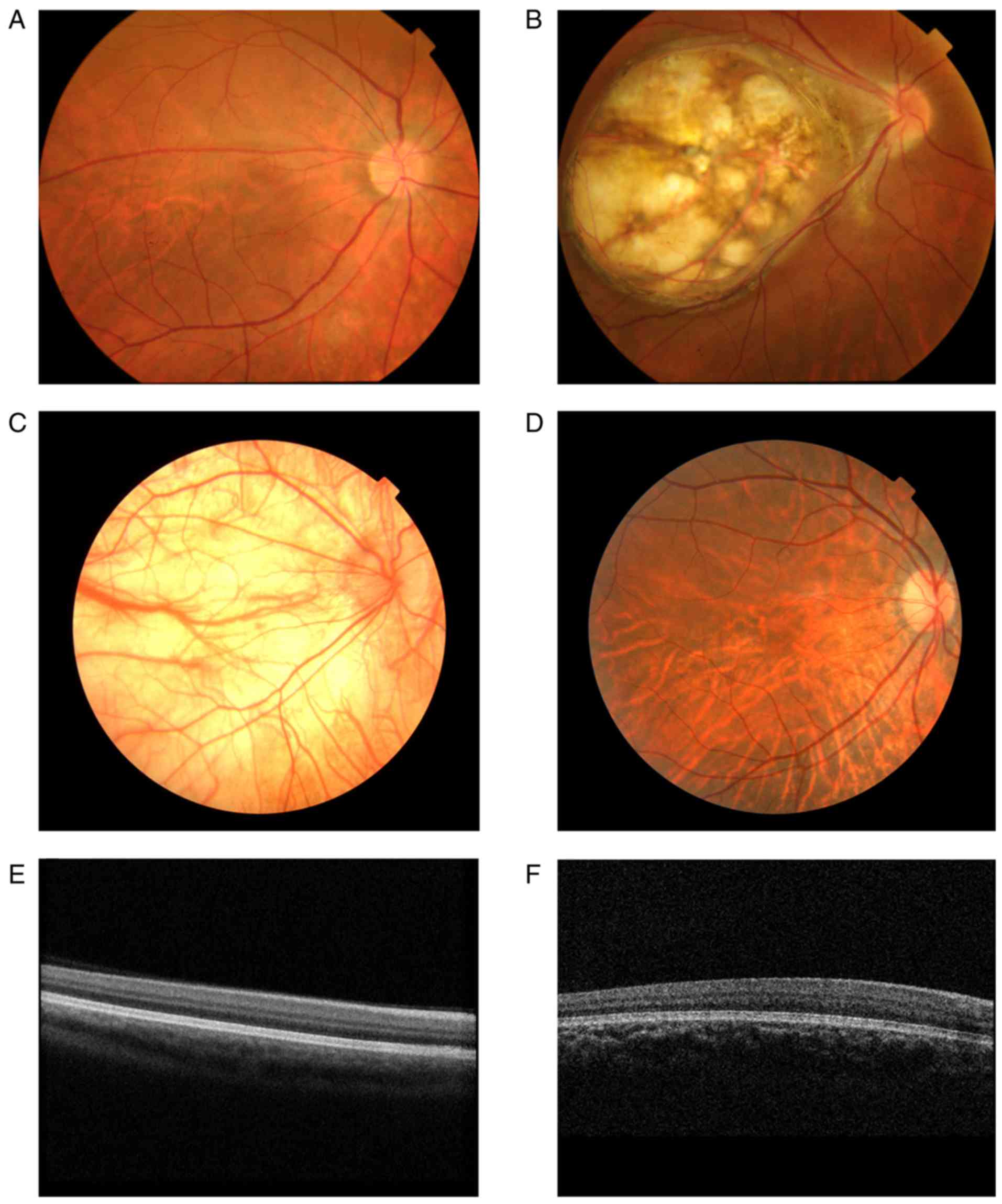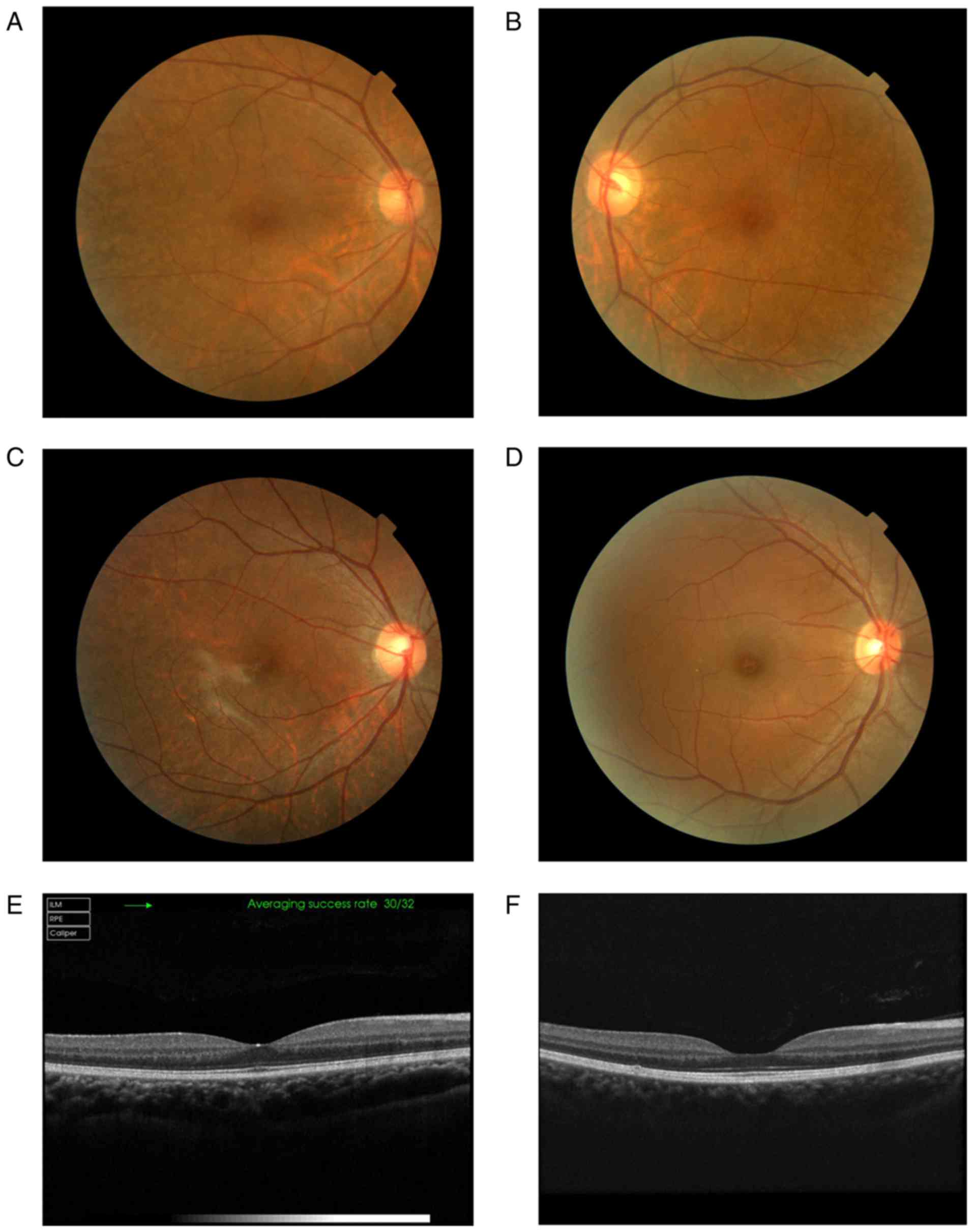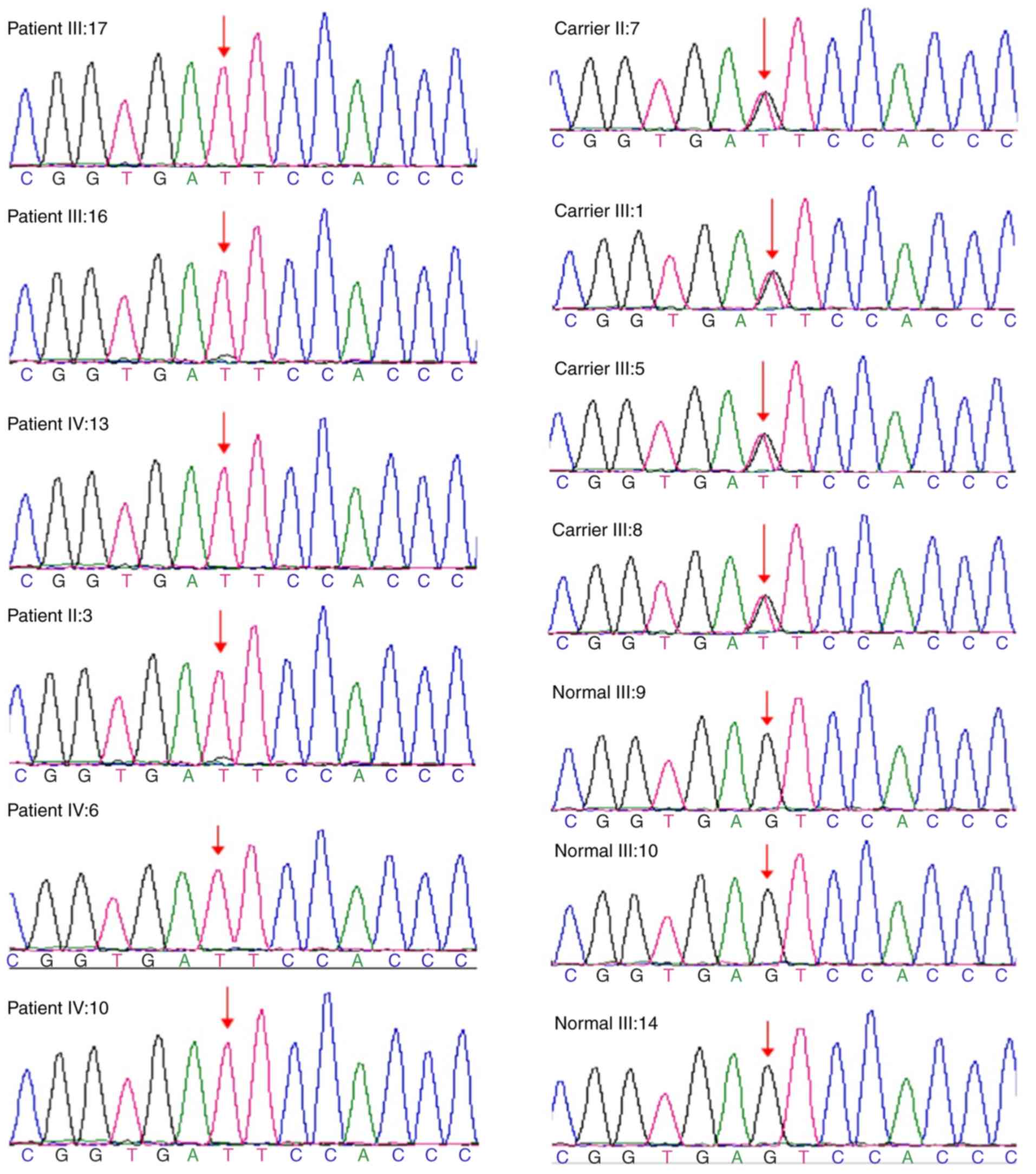A novel GPR143 mutation in a Chinese family with X‑linked ocular albinism type 1
- Authors:
- Published online on: November 12, 2019 https://doi.org/10.3892/mmr.2019.10813
- Pages: 240-248
-
Copyright: © Gao et al. This is an open access article distributed under the terms of Creative Commons Attribution License.
Abstract
Introduction
Albinism is a rare hereditary disease associated with an absence of pigment in the eyes, skin and hair, due to congenital defects in melanocytes. Oculocutaneous albinism and ocular albinism type 1 (OA1) are the two main subtypes of albinism. The birth prevalence of OA1 is ~1 in 60,000 (1); however, reports on Chinese patients with OA1 are rare and epidemiological data are lacking. Compared with other types of albinism, patients with OA1 appear to be almost exclusively males and present with only ocular abnormalities. OA1 is characterized by varying degrees of iris depigmentation, nystagmus, loss of stereoscopic vision, foveal hypoplasia, fundus hypopigmentation and reduced visual acuity (2–6). Female carriers do not exhibit clinical symptoms but have spotty or patchy pigment loss in the fundus, which is also considered a characteristic of OA1 (7).
OA1 has a Mendelian inheritance pattern and the G protein-coupled receptor 143 gene (GPR143; OMIM: #300808, NCBI gene ID: 4935) has been identified as the disease-causing gene. The GPR143 gene, which has also been reported to cause congenital nystagmus, possesses nine exons and spans ~40 kb of genomic DNA (8). GPR143 encodes proteins that are important for the development and maturation of melanosomes, and is only localized in the lysosomes and melanosomes of cells (9). A previous study reported that OA1 is a disorder involving protein misfolding as a pathogenic mechanism, rather than the lack of melanin synthesis (10). The typical clinical features of OA1 are iris and fundus depigmentation, nystagmus, foveal hypoplasia, and normally pigmented skin and hair. In addition, OA1 is often associated with reduced visual acuity.
Since iris or fundus depigmentation are very slight and insidious among Asian patients with OA1, it can easily be misdiagnosed as other congenital eye diseases, such as congenital idiopathic nystagmus (CIN), although the treatment principle for OA1 and CIN is the same (11–16). Molecular diagnosis combined with detailed eye examinations, including optical coherence tomography (OCT) and detailed slit lamp examination, are effective tools for differential diagnosis (17–20). In the present study, the clinical manifestations were described and a molecular genetic analysis was performed on a Chinese family with X-linked OA1. Reports of X-linked OA1 in Asian populations are relatively rare (7–16); therefore, the present results may enrich the mutation spectrum of GPR143 in the Asian population.
Materials and methods
Recruitment of subjects
A total of 18 members of a family affected by OA1 (nine affected patients and nine normal subjects), from Sanya (Hainan, China), were recruited to the present study in December 2017 at the Department of Ophthalmology, Chinese PLA General Hospital. This study was approved by the Hospital Ethics Committee and strictly followed the Helsinki Declaration. All participants provided written informed consent. Additionally, 100 healthy normal people (50 men and 50 women) between the age of 18–65 years were recruited as controls in the present study.
Patient assessment
Detailed family and medical histories were collected. All participants underwent careful ophthalmologic testing, which covered the first occurrence of nystagmus, intraocular pressure, anterior segment of the eyes, best corrected visual acuity (BCVA), indirect ophthalmoscopy and fundus photography for vitreous and fundus examination, OCT for retinal structure examination and electrophysiological assessment.
Genetic mutation screening
Blood samples (8–10 ml) were collected from six affected patients and seven normal individuals within the 18 family members. Genomic DNA was extracted from blood lymphocytes using a SeqCap EZ MedExome target enrichment kit (Tiangen Biotech Co., Ltd.) according to the manufacturer's protocol. A high-throughput sequencer Illumina HiSeq2500 Analyzer (Illumina, Inc.) was used for continuous bidirectional sequencing for 90 cycles and the raw sequencing numbers were read using Illumina Pipeline software (version 1.3.4; Illumina, Inc.). SOAPsnp software (SOAPsnp-v1.03.tar.gz; http://soap.genomics.org.cn) and Samtools software (Samtools version 0.1.19; http://samtools.sourceforge.net/) were used to perform single nucleotide variant and insertion and deletion analysis, in order to generate the target region base polymorphism results. The primer and Illumina sequencing reaction conditions were performed by Beijing Huada Gene Technology, Ltd. The coding exon and intron sequences of the GPR143 gene were amplified by polymerase chain reaction (PCR). The PCR reaction conditions were as follow: Initial denaturation at 95°C for 5 min, followed by 35 cycles at 94°C for 30 sec, annealing at 58°C for 30 sec and 72°C extension for 30 sec, and a final extension cycle at 72°C for 5 min. The reaction products were purified using the Purification kit (Qiagen GmbH) and BigDye Terminator v3.1 Cycle Sequencing kit (Thermo Fisher Scientific, Inc.) was used for Sanger Sequencing, according to the manufacturer's protocol. The genes were read using an ABl3130 sequencer (Thermo Fisher Scientific, Inc.), in accordance with the manufacturer's protocol. The sequencing outcomes were analyzed using Chromas 2.0 (Technelysium Pty Ltd.) and DNAStar 8.0 software (http://www.dnastar.com). The sequencing results were compared with the Reference Sequence (RefSeq; release 34; http://www.ncbi.nlm.nih.gov/LocusLink/refseq.html) database, and the identified novel mutation was named according to the nomenclature recommended by Human Genome Variation Society (http://www.hgvs.org/). Sanger sequencing was also performed on the GPR143 gene in samples collected from 100 healthy individuals.
Results
Clinical phenotype
All of the affected patients in the recruited family were male and were the offspring of female carriers of the mutation; men with the mutation develop the disorder, whereas women can be carriers or healthy individuals. This is in line with X-linked recessive inheritance (Fig. 1). All patients with OA1 exhibited different degrees of horizontal nystagmus and low BCVA. The patients exhibited nystagmus from birth to 6 months of age, and the BCVA data ranged between 0.1 and 0.4. All carriers presented normal BCVA and no symptoms (Tables I and II).
Using slit lamp examination, nine patients were observed to have different degrees of abnormal iris pigmentation. Some patients exhibited peripheral iris depigmentation in a ring or fan and there was only one patient who did not present depigmentation of the iris. In addition, a slight depigmentation of the iris was also observed in all the carriers (Fig. 2).
According to the fundus examination, nine patients presented different degrees of retinal hypopigmentation and foveal hypoplasia. The choroidal blood vessels of some patients were clearly visible due to retinal depigmentation (Fig. 3A). In addition, one patient (III:16) had a normal iris with a large choroid membrane coloboma at the fundus of the eye (Fig. 3B). The fundi of some patients presented irregular retinal alternating shades of pigment, which resembled highly myopic eyes (Fig. 3D). OCT examination could not visualize the macular foveal structures in nine patients (Fig. 3E and F). The participants in this study presented with normal skin and hair color. Only one patient (IV:13) exhibited light brown hair with complete depigmentation at the fundus (Fig. 3C). In addition, the carriers with normal foveae exhibited slight spotty depigmentaton in the peripheral fundus of the eyes (Figs. 3 and 4).
Mutation analysis
Following Illumina sequence analysis of the GPR143 gene, the proband III:17 and 5 patients with OA1 underwent mutation analysis; the hemizygous mutation c.360+5G>T in GPR143 gene was detected on II:3, III:16, III:17, IV:6, IV:10 and IV:13 in this family (Fig. 5). However, the clinical significance of this mutation was not clear.
Validation
Sanger sequencing of the GPR143 gene c.360+5G>T site was performed on 12 participants of this family, with the exception of the proband III:17 (sequencing was completed by Beijing Huada Gene Technology, Ltd.). The results revealed that four cases (II:7, III:1, III:5 and III:8 carriers) exhibited heterozygous mutations and three cases (III:9, III:10, and III:14 normal individuals) did not possess the mutation (Fig. 5).
The mutation c.360+5G>T described was absent in the 100 normal controls. These findings indicated that the c.360+5G>T mutation in the GPR143 gene was a novel mutation site that leads to OA1. This mutation may be the pathogenic mutation site of the recruited family.
Discussion
The present study described the clinical features of a Chinese family with OA1; a novel mutation in the GPR143 gene (c.360+5G>T) was detected in this family. All patients had normally pigmented skin and hair but presented with different degrees of iris depigmentation, horizontal jerk nystagmus, low BCVA and foveal hypoplasia.
There have been many reports in Caucasian individuals regarding the clinical characteristics and pathogenic mechanism of OA1 (21,22). In addition, it has been reported that OA1 in African-American patients presents as non-albinotic, with no translucency of the iris and a moderately pigmented fundus; however, during ophthalmoscopic examination, these patients always present foveal hypoplasia (23). It has been reported that Japanese patients with OA1 exhibit fundus pigmentation to a degree somewhere between Caucasian patients and patients of African descent (24). In 2008, Fang et al (13) first reported clinical studies of OA1 in the Chinese population. It has been demonstrated that regardless of race, all patients with OA1 consistently exhibit signs of foveal hypoplasia (14,20–24). It is thought that ~80% of heterozygous female carriers exhibit an alternating pattern of streaks of pigment with streaks of low pigment in the fundus (25). This is consistent with the present study. This study revealed that even in female carriers, one X chromosome carried the disease gene, whereas the other X chromosome carried the normal GPR143 gene, which can induce the expression of the normal OA1 protein.
The GPR143 gene, which spans ~40 kb and encodes a 404 amino acid membrane glycoprotein, is located on chromosomal region Xp22.3. The GPR143 protein is mainly expressed in the iris, retinal pigment epithelium and melanocytes (19,26). As a receptor of tyrosine, levodopa and dopamine, the GPR143 protein has been reported to regulate the early stages of melanosome biogenesis, organization and signal transduction (27,28). Until now, the Human Gene Mutations Database (http://www.hgmd.cf.ac.uk) has described >100 mutations in the GPR143 gene that have been reported to be responsible for OA1.
OA1 is easily misdiagnosed as other diseases, particularly in East Asian patients, as patients with brown irises usually have no typical iris hypopigmentation or albinotic type of retinal pigment. In the present study, patients were initially misdiagnosed as having CIN, as CIN exhibits similar features to those of OA1. Therefore molecular testing combined with comprehensive clinical analysis is a good method for accurate diagnosis, particularly when clinical symptoms are conflicting. The patients within the present family exhibited congenital nystagmus between birth and 6 months of age; the symptoms included horizontal pendular nystagmus, which was accompanied by head tremor, amblyopia and poor lateral vision. All patients presented different degrees of retinal hypopigmentation in the fundus as well as severe foveal hypoplasia. It was speculated that there may be possible linkage inheritance of albinism with nystagmus. It has been confirmed that the GPR143 gene is both the pathogenic gene of OA1 and the pathogenic candidate gene of congenital nystagmus (16–19). However, how the two diseases interact with each other requires further study. In the examination of the anterior segment, all patients with OA1, with the exception of one, exhibited iris depigmentation in the shape of a ring or fan. This is consistent with previous reports in Chinese OA1 families (14,29).
This study confirmed the GPR143 gene mutation through Sanger sequencing and detected a hemizygous mutation (c.360+5G>T) in the affected family; this mutation is a splicing mutation. The mutation was detected in six patients in this family and was later verified to be absent in 100 healthy people who did not have the disease and had no family history of OA1. Therefore, the novel splicing mutation in the GPR143 gene, c.360+5G>T, was identified as the pathogenic mutation of this OA1 family. However, the prevalence of this GPR143 mutation in Chinese patients is unclear.
The novel mutation c.360+5G>T is located in the shearing area after exon 4 of the GPR143 gene, changing the shear of RNA and affecting the stability and translation of RNA. Splicing mutations are a type of mutation that changes the splicing mode of RNA precursors due to a mutation of the splicing donor, receptor site or its side conservative sequence, which results in mature RNA containing a class of mutations that contain intron or missing exon sequences. In the present study, the fifth intron in the shearing area after exon 4 was mutated from the original G base to a T base, thereby resulting in a change from AGT-serine to ATT-isoleucine; this alteration may lead to abnormal functional or structural characteristics of terminal protein products. Therefore, this may be the ultimate cause of the disease in this affected family. It has been speculated that transcriptional mutations may lead to a reduction in the function of the nonsense-mediated mRNA degradation pathway, thus leading to the generation of truncated proteins that affect function (30,31); however, the specific pathogenesis requires further study and confirmation.
In conclusion, the present study identified a novel mutation in the GPR143 gene in a Chinese family affected by OA1; the mutation c.360+5G>T was successfully located. This study expanded the mutation spectrum of the GPR143 gene, particularly enriching our current knowledge on the GPR143-associated OA1, thereby supporting future genetic diagnosis and treatment of OA1. The results of this study, combined with other novel mutations affecting the GPR143 protein, may provide a basis for further proteomics research. Genetic analysis, as well as careful clinical examination, may contribute to the accurate diagnosis of disorders and may inform genetic counseling, providing information about prognosis and avoiding unnecessary and inappropriate interventions.
Acknowledgements
The authors would like to thank Miss Hong Jiang and Mr Bing Chen of Chinese PLA General Hospital, for contributing to fundus photography and optical coherence tomography used in the present study.
Funding
No funding was received.
Availability of data and materials
All data generated or analyzed during the present study are included in this published article.
Authors' contributions
TCL made substantial contributions to the conception and design of the current study. MNZ performed test method guidance. LW collected blood specimen. AD collected the clinical data. XC analyzed and interpreted the patient data. RPL analyzed the sequencing results. XHG interpreted the data and wrote the manuscript. All authors read and approved the final manuscript.
Ethics approval and consent to participate
The present study was approved by The Hospital Ethics Committee and strictly followed the Helsinki Declaration. All participants provided written informed consent.
Patient consent for publication
All participants provided written informed consent for publication.
Competing interests
The authors declare that they have no competing interests.
References
|
Rosenberg T and Schwartz M: X-linked ocular albinism: Prevalence and mutations-a national study. Eur J Hum Genet. 6:570–577. 1998. View Article : Google Scholar : PubMed/NCBI | |
|
Preising M, Op de Laak JP and Lorenz B: Deletion in the OA1 gene in a family with congenital X linked nystagmus. Br J Ophthalmol. 85:1098–1103. 2001. View Article : Google Scholar : PubMed/NCBI | |
|
Sallmann GB, Bray PJ, Rogers S, Quince A, Cotton RG and Carden SM: Scanning the ocular albinism 1 (OA1) gene for polymorphisms in congenital nystagmus by DHPLC. Ophthalmic Genet. 27:43–49. 2006. View Article : Google Scholar : PubMed/NCBI | |
|
Lam BL, Fingert JH, Shutt BC, Singleton EM, Merin LM, Brown HH, Sheffield VC and Stone EM: Clinical and molecular characterization of a family affected with X-linked ocular albi-nism (OA1). Ophthalmic Genet. 18:175–184. 1997. View Article : Google Scholar : PubMed/NCBI | |
|
O'Donnell FE Jr, King RA, Green WR and Witkop CJ Jr: Autosomal recessively inherited ocular albinism. A new form of ocular albinism affecting females as severely as males. Arch Ophthalmol. 96:1621–1625. 1978. View Article : Google Scholar : PubMed/NCBI | |
|
Cortin P, Tremblay M and Lemagne JM: X-linked ocular albinism: Relative value of skin biopsy, iris transillumination and funduscopy in identifying affected males and carriers. Can J Ophthalmol. 16:121–123. 1981.PubMed/NCBI | |
|
Zou X, Li H, Yang L, Sun Z, Yuan Z, Li H and Sui R: Molecular genetic and clinical evaluation of three Chinese families with X-linked ocular albinism. Sci Rep. 6:337132017. View Article : Google Scholar | |
|
Bassi MT, Schiaffino MV, Renieri A, De Nigris F, Galli L, Bruttini M, Gebbia M, Bergen AA, Lewis RA and Ballabio A: Cloning of the gene for ocular albinism type 1 from the distal short arm of the X chromosome. Nat Genet. 10:13–19. 1995. View Article : Google Scholar : PubMed/NCBI | |
|
Palmisano I, Bagnato P, Palmigiano A, Innamorati G, Rotondo G, Altimare D, Venturi C, Sviderskaya EV, Piccirillo R, Coppola M, et al: The ocular albinism type 1 protein, an intracellular G protein-coupled receptor, regulates melanosome transport in pigment cells. Hum Mol Genet. 17:3487–3501. 2008. View Article : Google Scholar : PubMed/NCBI | |
|
d'Addio M, Pizzigoni A, Bassi MT, Baschirotto C, Valetti C, Incerti B, Clementi M, De Luca M, Ballabio A and Schiaffino MV: Defective intracellular transport and processing of OA1 is a major cause of ocular albinism type 1. Hum Mol Genet. 9:3011–3018. 2000. View Article : Google Scholar : PubMed/NCBI | |
|
Liu JY, Ren X, Yang X, Guo T, Yao Q, Li L, Dai X, Zhang M, Wang L, Liu M and Wang QK: Identification of a novel GPR143 mutation in a large Chinese family with congenital nystagmus as the most prominent and consistent manifestation. J Hum Genet. 52:565–570. 2007. View Article : Google Scholar : PubMed/NCBI | |
|
Wang Y, Guo X, Wei A, Zhu W, Li W and Lian S: Identification of a novel mutation in a Chinese family with X-linked ocular albinism. Eur J Ophthalmol. 19:124–128. 2009. View Article : Google Scholar : PubMed/NCBI | |
|
Fang S, Guo X, Jia X, Xiao X, Li S and Zhang Q: Novel GPR143 mutations and clinical characteristics in six Chinese families with X-linked ocular albinism. Mol Vis. 14:1974–1982. 2008.PubMed/NCBI | |
|
Xiao X and Zhang Q: Iris hyperpigmentation in a Chinese family with ocular albinism and the GPR143 mutation. Am J Med Genet A 149A. 1786–1788. 2009. View Article : Google Scholar | |
|
Yan N, Liao X, Cai SP, Lan C, Wang Y, Zhou X, Yin Y, Yu W and Liu X: A novel nonsense mutation of the GPR143 gene identified in a Chinese pedigree with ocular albinism. PLoS One. 7:e431772012. View Article : Google Scholar : PubMed/NCBI | |
|
Cai CY, Zhu H, Shi W, Su L, Shi O, Cai CQ, Ling C and Li WD: A novel splicing site mutation of the GPR143 gene in a Chinese X-linked ocular albinism pedigree. Genet Mol Res. 12:5673–5679. 2013. View Article : Google Scholar : PubMed/NCBI | |
|
Pan Q, Yi C, Xu T, Liu J, Jing X, Hu B and Wang Y: A novel mutation, c.494C>A (p.Ala165Asp), in the GPR143 gene causes a mild phenotype in a Chinese X-linked ocular albinism patient. Acta Ophthalmol. 94:417–418. 2015. View Article : Google Scholar : PubMed/NCBI | |
|
Hu J, Liang D, Xue J, Liu J and Wu L: A novel GPR143 splicing mutation in a Chinese family with X-linked congenital nystagmus. Mol Vis. 17:715–722. 2011.PubMed/NCBI | |
|
Han R, Wang X, Wang D, Wang L, Yuan Z, Ying M and Li N: GPR143 gene mutations in five chinese families with X-linked congenital nystagmus. Sci Rep. 5:120312015. View Article : Google Scholar : PubMed/NCBI | |
|
Kinnear PE, Jay B and Witkop CJ Jr: Albinism. Surv Ophthalmol. 30:75–101. 1985. View Article : Google Scholar : PubMed/NCBI | |
|
Charles SJ, Green JS, Grant JW, Yates JR and Moore AT: Clinical features of affected males with X linked ocular albinism. Br J Ophthalmol. 77:222–227. 1993. View Article : Google Scholar : PubMed/NCBI | |
|
Schnur RE, Wick PA, Bailey C, Rebbeck T, Weleber RG, Wagstaff J, Grix AW, Pagon RA, Hockey A and Edwards MJ: Phenotypic variability in X-linked ocular albinism: Relationship to linkage genotypes. Am J Hum Genet. 55:484–496. 1994.PubMed/NCBI | |
|
O'Donnell FE Jr, Green WR, Fleischman JA and Hambrick GW: X-linked ocular albinism in Blacks. Ocular albinism cum pigmento. Arch Ophthalmol. 96:1189–1192. 1978. View Article : Google Scholar : PubMed/NCBI | |
|
Hayakawa M, Kanai A, Kato K, Nakajima A and Takamori K: A Japanese family of nettleship falls X-linked ocular albinism. Nippon Ganka Gakkai Zasshi (Japanese). 94:1181–1187. 1990. | |
|
Oetting WS: New insights into ocular albinism type 1 (OA1): Mutations and polymorphisms of the OA1 gene. Hum Mutat. 19:85–92. 2002. View Article : Google Scholar : PubMed/NCBI | |
|
Sone M and Orlow SJ: The ocular albinism type 1 gene product, OA1, spans intracellular membranes 7 times. Exp Eye Res. 85:806–816. 2007. View Article : Google Scholar : PubMed/NCBI | |
|
Schiaffino MV, d'Addio M, Alloni A, Baschirotto C, Valetti C, Cortese K, Puri C, Bassi MT, Colla C, De Luca M, et al: Ocular albinism: Evidence for a defect in an intracellular signal transduction system. Nat Genet. 23:108–112. 1999. View Article : Google Scholar : PubMed/NCBI | |
|
Giordano F, Bonetti C, Surace EM, Marigo V and Raposo G: The ocular albinism type 1 (OA1) G-protein-coupled receptor functions with MART-1 at early stages of melanogenesis to control melanosome identity and composition. Hum Mol Genet. 18:4530–4545. 2009. View Article : Google Scholar : PubMed/NCBI | |
|
Jia X, Yuan J, Jia X, Ling S, Li S and Guo X: GPR143 mutations in Chinese patients with ocular albinism type 1. Mol Med Rep. 15:3069–3075. 2017. View Article : Google Scholar : PubMed/NCBI | |
|
Inoue K, Khajavi M, Ohyama T, Hirabayashi S, Wilson J, Reggin JD, Mancia P, Butler IJ, Wilkison MF, Wegner M and Lupski JR: Molecular mechnism for distinct neurological phenotypes conveyed by allelic truncating mutations. Nat Genet. 36:361–369. 2004. View Article : Google Scholar : PubMed/NCBI | |
|
Holbrook JA, Neu-Yilik G, Hentze MW and Kulozik AE: Nonsense-mediated decay approaches the clinic. Nat Genet. 36:801–808. 2004. View Article : Google Scholar : PubMed/NCBI |



